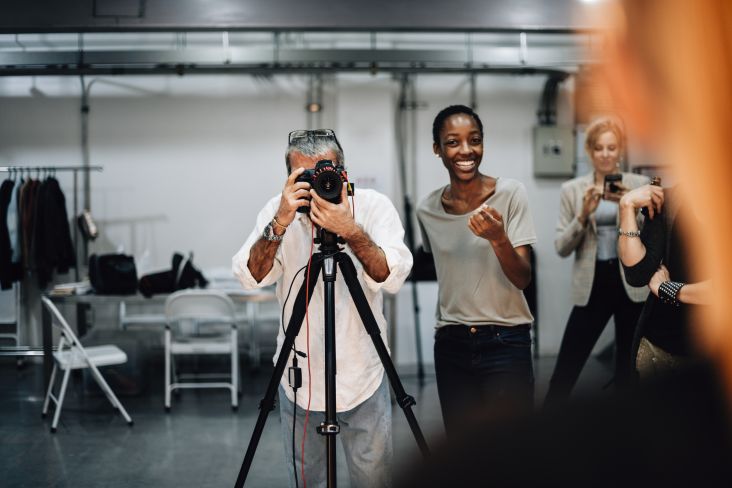Creative freelancers reveal their rates and share top tips for pricing your work
Deciding what to charge is one of the biggest challenges of being a freelancer. But you don't have to work it out all by yourself. We've rounded up some great advice from professional creatives, based on the benefit of their experience.

Image licensed via Adobe Stock
It's one of the most maddening things about freelancing: how do you set your rates? On the one hand, you need to pay the rent and bills and don't want to price yourself out of the market. On the other, the idea there might be people earning more than you is a constant niggle.
Worse still, there doesn't seem to be one universally agreed way to decide your rates. And so most of us just muddle through. But if you don't put proper thought into setting your rates, you could be losing thousands every year as a result. So it's worth putting some time and effort into getting it right.
To help you out, we've gathered tips and advice from creative freelancers who've been kind enough to share their process and – even more helpfully – the actual amounts they charge.
Of course, everyone's level of skill, experience and specialist knowledge is different, so don't assume that the specific rates they charge will necessarily apply to everyone. But at least it will help give you a baseline to think about your freelance rates and how you can get there over time.
1. Research the market
In general, what people get paid is not about fairness, the usefulness of your work to society, or the amount of effort you put in: otherwise nurses, teachers and other caring professions would get a lot more than they do. Ultimately, it's about market value: how much people need your services (demand) and how many others offer the same services (supply).
For this reason, there's no universally agreed rate of pay for illustrators, designers and so on across the world. Depending on how supply and demand change, rates will rise and fall in different places at different times. So to get a rough idea of what you should be charging, you must research the current market.
That's exactly how freelance XR designer Nuria Quero went about things. "The way I calculated it when I first started is by talking to a friend who had been freelancing and sharing his rates, as well as looking at the standards for that position," she recalls.
Iancu Barbărasă, a freelance graphic designer and illustrator, has taken a similar approach. "When I work as a freelance designer for agencies and studios, I charge between £375 and £450 per day, depending on my role and responsibilities as part of the team and the booking length," he explains. "These rates are based on the industry standards, as mentioned by salary surveys published by recruiters like Major Players, YunoJuno or Nikky Lyle."
Search social media and the web, and ask around the profession, and you should be able to turn up surveys relevant to your skillset and area. For example, motion designers should check out the Motion day rate survey by Patrick Gallagher. Female animators should head to the She Drew That salary report. And freelance illustrator Sam Osborne notes that if you become a member of The Association of Illustrators, you can get access to pricing guides that help you understand industry standard costs and charge for your services more confidently.
Of course, with rates varying so much, you'll need to do a lot of work on this, says Livia Lucie, a freelance graphic designer. "I currently charge £350 a day which I'm quite happy with," she says. "But it was difficult getting there and required lots of research. I eventually found a really interesting site with loads of illustrations and visualised data, which unfortunately doesn't seem to exist any more. It had different design jobs, and the average rate was split into men and women. Women were constantly £70-90 lower than men. So I decided to run with the men's rate."
Don't expect everyone to play ball, she adds. "I've had one person at an agency say, 'The maximum we pay our designers is £200-220', and another person almost fall off their chair on a video call," he recalls. "But everyone else has been fine, and fingers crossed, I'm currently booked until June."
2. Research how agencies bill clients
As well as finding out what agencies are paying freelancers, it's also worth researching what clients are paying agencies directly. That's what Chris Corum did, and it seems to be paying off well for him.
"I'm an art director and creative director," he says. "Sometimes I do creative leadership as a freelancer: ACD, CD, management, mentorship, and so on, but usually I function as a senior creative. I work with ad agencies and directly, mostly with corporate clients. My day rate ranges from $1,200 to $1,500, although I've gotten as high as $1875. My hourly rate is $100-150, but usually around $125 per hour."
So what's his secret? "I got there because I know basically what agencies bill our time to clients at anywhere from $95 for small agencies and small clients up to around $200 for holding company agencies and big corporate clients.
The math for me works out for him like this. "They won't pay more than they make/charge," Chris explains. "They scope clients mid-high but bill almost exactly what I work. When they scope clients low, they'll either take a loss on you because they're trying to win the business or secure the relationship. My rate doesn't change much between Minneapolis, Chicago, Kansas City, Seattle, and New York City."
Chris is clearly at the top of his game, and let's be honest: he earns a heck of a lot more than the vast majority of creatives will ever dream of. But his experience does highlight how a little insider business knowledge can go a long way when setting your rates.
3. Be flexible
Once you've set your rates, it's important to stick to your guns and not be talked down by cheap clients. But at the same time, it's good to retain some flexibility. And most freelancers are, in reality, willing to drop them a little for the right project.
"In general, I work on a day rate, and I charge between £325-425," explains Nuria. "But I don't have a specific rate because it might vary depending on the project. There are different aspects I consider: length of the contract, seniority and skills required. After all, it's not the same being hired for six months part-time and working full-time for a couple of weeks. I'll also take into account whether I'm the lead UX on the project or if it requires me to do some coding."
Iancu also allows clients some wiggle room on occasion. "It's rare, but I might use a lower rate if the client is small – usually a one-person studio – and the project is very interesting," he explains.
4. Hourly vs day rates
Should you charge hourly, daily or per project? Creative freelancers tend to have a range of views on this… but we've found most are wary of hourly pricing.
"When I worked hourly, I slotted so much in one day, I was exhausted," says Livia. Nowadays, she finds that charging per day works better for her. "I have a good idea of what I'll be earning and when I'll be working," she explains.
Interior, architecture and aerial photographer Jak Spedding tells a similar story. "The minimum I charge is a half-day rate, which is £350 plus VAT and expenses, and covers roughly four hours on site," he says. "Bigger jobs are charged at a day rate, which is £650 and covers eight hours. I did start out offering hourly fees but soon found it was a false sense of economy for the client, and often they'd end up paying more once setup, retouching and so on were included. Whenever someone says: 'We only need a few shots, shouldn't be more than an hour's work', it soon turns into them needing 20 shots very quickly."
Not everyone approaches charging in the same way, though. Take senior creative artworker Beth Cole. "For most clients and projects, I work on an hourly basis," she says. "My hourly rate is £30, although, for smaller businesses and startups, I occasionally work on a price per-project basis, which will include two rounds of amends. Anything extra will need to be priced additionally.
"I give the client a time estimate before the project starts, which they will approve, or adjust deliverables and project if necessary," she adds. "If for any reason – such as additional content or materials needed – I suspect we may go over the hours, I make sure this is communicated to the client, so there are no hidden costs at the end."
5. Fixed fee vs day rate
What about charging per day versus charging per project? Again, there's no clear consensus on which is better here, and some freelancers will switch between one and the other depending on the situation.
"I only price on a half or full day," says Jak. "When I started working for myself six years ago, I used to price each project individually. But I found most projects I take on fit within a certain timeframe or amount of work, and it was taking a lot of my time individually pricing each job. Streamlining this freed me up to spend more time on other tasks."
Iancu, however, takes a different approach. "When I work directly with a client, I charge a fixed fee per project," he says. "The fee always depends on the size of the client's company and their field. A project for a street corner bakery run by one person will cost less than a project done for a corporate company with 50 or more employees.
"To calculate the fee, I use my 'minimum day rate', based on how much I need to make in order to cover my costs in a year and add more to it depending on the client's size and type of business," he adds. "This gives me a rough day rate for that particular project, which I multiply with how many days I think the work would take to get the fixed cost/fee that I share with the client."
For example, for a recent corporate client with around 50 employees, his rough day rate was £550. For a much smaller business in publishing, with only three or four employees, his rough day rate would be £390. "The fixed fee works well in most cases because the clients have a clear budget – even if it takes a bit of talking to find out what that is – and they don't want to go over it," he says.
That said, Iancu had to switch from the fixed fee system to a day rate system with some tricky clients. "They kept changing the brief throughout the project, which meant that our initial agreed fee and timing estimates were no longer covering the work," he explains. "When I see this starting to happen, I first explain that I can do the newly requested work instead of some previously agreed work so that the budget and timing stay the same. If the client still wants everything, we either change the agreed fee or switch to the day rate system."
6. Clarify everything
If one theme is emerging here, it's that one of the biggest problems with pricing up a job is the gap between expectations and reality. Most freelancers have had the experience of setting a fee, only to find the project's scope spiralling out of control, leaving them short-changed by the end of it.
For this reason, Nuria says, "the first thing I do is get clarification on the types of tasks I'll be performing, my responsibility and role within the project, deliverables, and timings. With that, I can assess my rate, as it might vary depending on the project."
And if those details aren't forthcoming? "If a client isn't able to give you that five minutes to really find out what they need, it's often not a job I want to take on," says Jak. "If it's not getting their full attention at this stage, things will only worsen as the job progresses."
It's all very well, of course, to agree on everything over a Zoom call. But Nuria adds that if you don't get that all in writing, you're in for a tough time further down the line.
"Once I have all the aspects of a project, I need to have it all written down in a contract," she explains. "As a freelancer, I try to protect myself as much as possible. I've been young and worked without one, and it was a terrible situation because you simply don't have ground to complain about when things go wrong. So huge tip: always work with a contract in place."





















